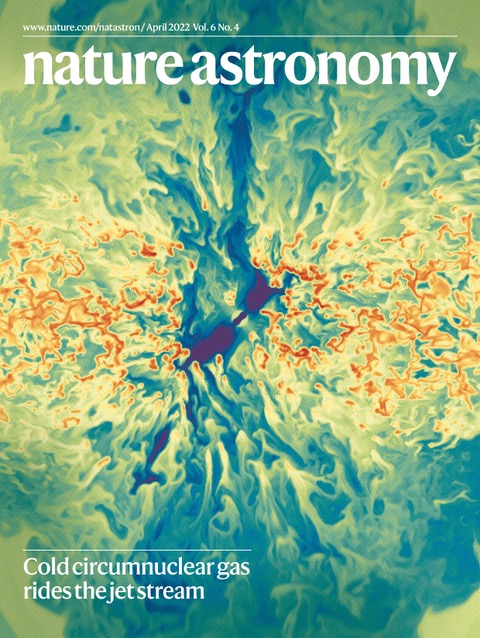 |
||
|
A low power jet from a supermassive black hole is seen to clear out gas from a galaxy's centre Scientists detect jets from a supermassive black hole blowing out gas from a galaxy |
||
Supermassive black holes at the centres of galaxies are known to give rise to fast moving jets of relativistic particles that can traverse large distances through the galaxy and beyond. An international team of astronomers, including Prof. Dipanjan Mukherjee from IUCAA, have now shown that even a relatively weak jet from a supermassive black hole can clear the nuclear region of the galaxy of its gas.
The study, led by astronomers in the Netherlands, Suma Murthy, Raffaela Morganti and Tom Osterloo from the Netherlands Institute for Radio Astronomy (ASTRON), involved observing the motions of molecular gas in the galaxy B2 0258+35, using the NOEMA (Northern Extended Millimetre Array) telescopes. The team also included Pierre Guillard from the Institut d'Astrophysique de Paris, France, Alexander Wagner from the University of Tsukuba, Japan, Dipanjan Mukherjee from IUCAA, India and Geoffrey Bicknell from the Australian National University, Australia, who aided in the interpretation of the observed results and comparison with theoretical simulations performed by Prof. Mukherjee and colleagues in 2018
Astronomers have found that gas is steadily being blown away from the central regions of the galaxy, pushed by the relativistic jet. Although the power of the jet observed in radio wavelengths is moderate, it is still capable of clearing out nearly 75% of the central gas reservoir. This is the first unambiguous detection of a relativistic jet from a supermassive black hole removing the gas in a galaxy. Competing mechanisms that can also cause such outflows have been ruled out in this case. The ejected gas is however is not fast enough to completely escape the galaxy, and will eventually fall back in.
This research showcases strong synergy between observational results and the simulations of relativistic jets interacting with a dense interstellar medium of a galaxy, carried out by Prof. Mukherjee in 2018. The results of these simulations have been compared with the observations of B2 0258+35 in this work. Astronomers find remarkable similarities between the predictions of the simulated gas kinematics and the observed dynamics of the molecular gas.
The study, led by astronomers in the Netherlands, Suma Murthy, Raffaela Morganti and Tom Osterloo from the Netherlands Institute for Radio Astronomy (ASTRON), involved observing the motions of molecular gas in the galaxy B2 0258+35, using the NOEMA (Northern Extended Millimetre Array) telescopes. The team also included Pierre Guillard from the Institut d'Astrophysique de Paris, France, Alexander Wagner from the University of Tsukuba, Japan, Dipanjan Mukherjee from IUCAA, India and Geoffrey Bicknell from the Australian National University, Australia, who aided in the interpretation of the observed results and comparison with theoretical simulations performed by Prof. Mukherjee and colleagues in 2018
Astronomers have found that gas is steadily being blown away from the central regions of the galaxy, pushed by the relativistic jet. Although the power of the jet observed in radio wavelengths is moderate, it is still capable of clearing out nearly 75% of the central gas reservoir. This is the first unambiguous detection of a relativistic jet from a supermassive black hole removing the gas in a galaxy. Competing mechanisms that can also cause such outflows have been ruled out in this case. The ejected gas is however is not fast enough to completely escape the galaxy, and will eventually fall back in.
This research showcases strong synergy between observational results and the simulations of relativistic jets interacting with a dense interstellar medium of a galaxy, carried out by Prof. Mukherjee in 2018. The results of these simulations have been compared with the observations of B2 0258+35 in this work. Astronomers find remarkable similarities between the predictions of the simulated gas kinematics and the observed dynamics of the molecular gas.
Significance of this research:
Links to the paper and related material:
(a) The study has been published in the April issue of the Nature Astronomy journal, with the cover page showcasing the image of Prof. Mukherjee's simulations from 2018.
 |
NatureAstronomy Cover Page: https://www.nature.com/natastron/volumes/6/issues/4 The original manuscript from the Nature Astronomy website can be accessed here (requires subscription): https://www.nature.com/articles/s41550-021-01596-6 Image credit: Nature Astronomy |
Full text on the publicly available ArXiv database can be found here:https://arxiv.org/abs/2202.05222
Nova press release:https://www.astronomie.nl/nieuws/en/less-powerful-black-hole-blows-environment-clean-after-all-3162
Nova press release:https://www.astronomie.nl/nieuws/en/less-powerful-black-hole-blows-environment-clean-after-all-3162
(b) Figures :

Figure 1: The image shows how the density in the mid-plane of the 3D simulation from Mukherjee et al. 2018 evolves with time under the influence of the jet. Initially (at t=0), the density is distributed as patchy clouds (in orange-red), representing a turbulent interstellar medium of a galaxy. At later times, the jets (represented by low density plasma in blue) push against the clouds, removing them to larger distances.
Image credit: Suma Murthy, Alexander Wagner, Dipanjan Mukherjee and collaborators from Murthy et al. 2022

Figure 2: The figure shows the distribution of velocity of the molecular gas observed in B2 0258+35. The Y axis represents the velocity of the outflowing gas. The X axis denotes the distance along the galaxy, measured in units of angular displacement from galaxy's centre as observed from earth (arc-seconds). The left image shows motions of the molecular gas distributed across the whole galaxy in colour and the gas disturbed by the jet in black contours.
The right image focuses on the gas in the central regions, being affected by the jet. The top image depicts the location of the jet in black contours, superimposed on the map of the velocity dispersion of the molecular gas. The image shows that the strongest outflow reaches velocities of nearly 400-500 kilometres per second, at a distance that is offset from the centre of the galaxy (by about 500 pc). The location of the outflow matches with region where the jet is flared and bent (as shown in the top panel), also corresponding to the higher velocity dispersion. This is indicates that the head of the jet is actively pushing the gas, as shown in the simulations.
Image credit: Suma Murthy, Raffaella Morganti and collaborators from Murthy et al. 2022
(c) Authors and Affiliation
Authors:
Suma Murthy 1,2,3, Raffaella Morganti 1,2, Alexander Y. Wagner 4, Tom Osterloo 1,2 Pierre Guillard 5, Dipanjan Mukherjee 6 and Geoffrey Bicknell 7
- Kapteyn Astronomical Institute, University of Groningen, Groningen, The Netherlands.
- The Netherlands Institute for Radio Astronomy (ASTRON), Dwingeloo, The Netherlands.
- Joint Institute for VLBI ERIC, Dwingeloo, The Netherlands.
- Center for Computational Sciences, University of Tsukuba, Tsukuba, Japan.
- Institut d’Astrophysique de Paris, Sorbonne Université, CNRS, Paris, France.
- Inter-University Centre for Astronomy and Astrophysics, Pune, India.
- Research School of Astronomy and Astrophysics, Australian National University, Weston, Australian Capital Territory, Australia.
Research contacts:
* please change _at_ to @
 |
Prof. Dipanjan Mukherjee Assistant Professor, Inter University Center for Astronomy and Astrophysics, Tel.: +91-20-25604-210 (Off.) E-mail: dipanjan_at_iucaa.in |